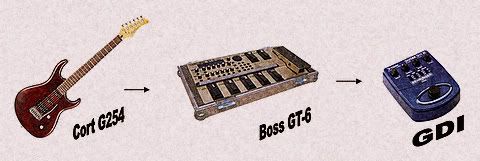
Joined: 20 Jun 2005
Posts: 1351
Location: Mont Kiara
|
| Quote: | The "Pitch Axis" Theory is a compositional technique that Joe has employed in a number of his pieces, simply because he loves the sound it creates.
Although the name may sound technical, it isn't such a difficult concept. It refers to the way in which a combination of modes can be used all in relation to one base note. That base note defines the overall 'key' and the modes played over the top create a mixture of different tonalities, instead of new key centers. The result can be anything from a beautiful to otherworldly sound.
Some of the pieces in which Joe has made use of the Pitch Axis technique are Not of This Earth, Always With Me, Always With You, With Jupiter In Mind and Satch Boogie.
The article below appeared in the April 1998 issue of 'Guitar' magazine and gives us some more insight into the Pitch Axis theory.
Joe Satriani introduced an important 20th Century composition technique to the rock arena, known as Pitch Axis. It's presented here not just to offer insight into Satriani's creative processes but as a bit of information that might spark creative impulses in you.
It has an impressive name, but pitch axis theory need not be complicated or intimidating. This compositional method is grounded on a simple idea, so the level of complexity or sophistication depends purely on application. The principle is that any number of harmonic settings can be linked by the same tonal center. Say you're in C major ( C D E F G A B C ) for four bars and C minor ( C D Eb F G Ab Bb C ) for the next four. The major and minor keys share the same tonic, C, and this note provides a pivot point on which to shift harmonies. You could then take four bars in, say,
C Phrygian ( C Db Eb F G Ab Bb ) and then four in C Mixolydian ( C D E F G A Bb ). Now a series of four distinct harmonies are adjoined, all of them revolving around
the same key center, C. Thus, one pitch provides an axis point for the scales and chords of a variety of harmonic situations.
Satriani learned the concept from a music theory teacher in high school, and instantly felt a fondness for it. "It was just one of those things where it's like a tuning fork goes off in your body," he laughs. "I thought, I like that." He cites 'Always With Me, Always With You' as a basic example. The song's first melody is in B major ( B C# D# E F# G# A# ), and is followed by a stretch in B minor ( B C# D E F# G A ). Joe explains, "I don't stray from B, so that's a pitch axis. As long as you keep the tonal center the same, then you're doing the pitch axis trick."
He continues, "I started to form the opinion that certain transitions from mode to mode sounded better, and certain others were just duds, there was no big deal about them. It's sort of like colours; you put two primary colours together and some of them just look okay, like yellow and red. But you put blue and red together and something happens."
Joe describes his song 'Not of This Earth' as "the ultimate pitch axis tune, because there's really only one pivotal bass note in the entire song!" The principal note is E, and almost the entire composition contains only that note as a pedal. The mode
structure is a repeated four-bar pattern: one bar of E Lydian, one bar of E Aeolian (natural minor), one bar of E Lydian and one bar of E Mixolydian. The pattern is implicit in the four opening chords of the song, and every melody and improvisation strictly follows those modal shifts.
In "Satch Boogie" Joe veers from the song's swinging stomp for a long pitch axis interlude of taps, pulls and hammers, played exclusively on the 5th string. You may have figured it was just a great improv, a tapping free-for-all, but Joe is quick to indicate that he approached the part methodically and meticulously. "That was something I worked on very carefully. Any time I'm working with pitch axis, everything is completely deliberate and worked out, if it's a set part. Some techniques you can really blow if you don't work it out, 'cause it really does sound like you're flailing away. There's a fine line between giving the sense of freedom and being too free. This is a definite little journey I'm taking the listener on, and it definitely leads back to (the song's head) when I'm done.
With the open 5th string ringing through in every measure, the axis pitch is clearly heard as an A. As Satriani describes, "Ultimately, (a pitch axis composition) is going to have a bass note that's staying in one place. The fewer notes you use in that area, the freer you are in your harmonic and melodic area."
Joe doesn't limit his pitch axis to the seven fundamental modes, but includes other scales as well, for instance A Harmonic minor |
Can someone explain this? omar.. i need ur help!! 
_________________
 |
|

